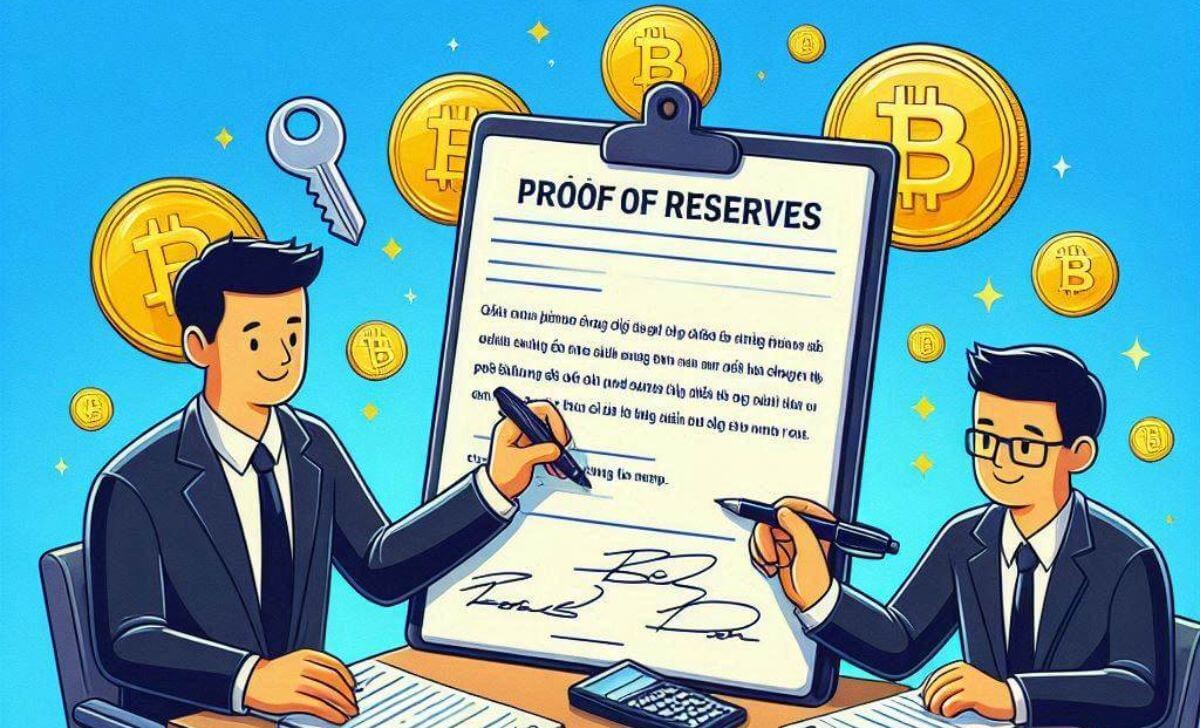Proof of Reserves (PoR) is an important concept in the crypto sector, especially in the wake of crises and the collapse of several major exchanges.
This article by AZCoin will give you an overview of PoR, from its definition, operating model, benefits, risks to its application in the crypto industry. Let’s follow the article to better understand Proof of Reserves and its role in the crypto ecosystem.
What are Proof of Reserves?

Proof of Reserves (PoR) is a method in the field of cryptocurrency and digital finance to provide transparency and trust in the reserve assets of institutions such as crypto exchanges. This is a form of transparent auditing that helps determine and prove that a user’s balance stored on the exchange actually exists and is sufficient to satisfy their withdrawal requests.
How operation of Proof of Reserves

Here’s how PoR works:
- Create a record of assets and liabilities: PoR consists of two main parts: a current record of customer deposits (known as liabilities) and a collection of tokens held in the exchange’s addresses (known as assets). The goal is to ensure that assets and liabilities must match.
- Using Merkle trees: This is the most common method. A Merkle Tree is a data structure that helps aggregate customer deposits and reconcile them with the assets held by the exchange. This allows users to audit their account history without revealing their identity or private key.
- Verification by a third party: A PoR process is typically conducted by an independent auditor. This auditor will snapshot account balances and aggregate them into a Merkle Tree. Subsequently, the auditor will collect digital signatures from the exchange to prove ownership rights over the addresses on the chain with publicly verifiable balances.
- Checking and verification: Users can independently verify if their balances are included in the PoR process by comparing data pieces with the Merkle root. Any changes in the data would alter the Merkle root, aiding in detecting interference.
Benefits of Proof of Reserves

Enhancing transparency in the crypto industry
With the decentralized nature of the crypto industry, managing digital assets securely is a significant challenge for exchanges. PoR increases transparency in asset management by ensuring accuracy and mitigating potential risks.
Building trust among users
By providing clear evidence of asset balances, users can trust that exchanges have sufficient assets to meet their withdrawal demands. This fosters trust and attracts new users to exchanges implementing PoR.
Preventing fraudulent activities
Proof of Reserves also helps prevent fraudulent activities by exchanges. By requiring independent third-party verification and auditing, exchanges adhere to regulations and best practices in asset management, enhancing transparency and preventing fraudulent activities.
Potential risks when using Proof of Reserves

High costs
Implementing Proof of Reserves requires exchanges to collaborate with independent third parties to audit and verify asset balances. This can incur substantial costs for exchanges, especially those with high trading volumes.
Accuracy pressure
In proving the accuracy of asset balances, exchanges face significant pressure in managing and controlling assets. Any errors could impact user trust and potentially cause significant harm to the exchange.
Not completely ensuring transparency
While Proof of Reserves enhances transparency in the crypto industry, it is not a perfect solution. Exchanges could employ fraudulent techniques to make their asset balances appear accurate and reliable. This can lead users to remain unaware of the true state of the exchange’s assets.
Popular methods of Proof of Reserves

There are several popular methods to implement Proof of Reserves, each with its own advantages. Here are some key methods:
- Digital signatures: Some exchanges use digital signatures to prove ownership rights over addresses on the chain with publicly verifiable balances. This is often conducted by an independent auditor who collects digital signatures from the exchange.
- Verification by a third party: A PoR process is typically conducted by an independent auditor. This auditor will snapshot account balances and aggregate them into a Merkle Tree. Subsequently, the auditor will collect digital signatures from the exchange to prove ownership rights over the addresses on the chain with publicly verifiable balances.
- Public reporting: Some exchanges provide public reports of their asset balances, verifiable by anyone to ensure the exchange holds the assets they claim, including altcoins.
Proof of Reserves exchange tracking tool
Here are 4 popular Proof of Reserves tools:
CoinMarketCap
CoinMarketCap is a popular tool that provides detailed information about assets on exchanges, including their public wallet addresses and balances. With data updated every minute, CoinMarketCap ensures information is always current and is used by major exchanges like Binance, KuCoin, Bitfinex, OKX, Bybit, Crypto.com, and Huobi. For the latest updates, visit AZcoin – best crypto exchange 2024.
Nansen
Nansen is an advanced analytics tool that offers features for tracking on-chain flows and assets, supporting various types of assets and different exchanges. However, Nansen’s advanced features often require a paid subscription and may be challenging for beginners to use.
Glassnode
Glassnode provides detailed data on transactions and balances on-chain, supports multiple asset types and offers powerful analytical tools. While Glassnode’s premium features require a paid subscription, it provides comprehensive analysis and detailed data.
CryptoQuant
CryptoQuant offers real-time data on transactions and balances on-chain, with a user-friendly interface. Like other platforms, CryptoQuant’s advanced features also require a paid subscription and data accuracy can depend on the completeness of information provided by exchanges.
Is Proof of Reserves really the optimal solution?
While Proof of Reserves offers many benefits and potential in increasing transparency and building trust with users, it is not without drawbacks. Risks and challenges still exist when using PoR and implementing it can also incur costs and time for exchanges.
Therefore, the adoption of Proof of Reserves should be carefully considered by exchanges, ensuring accuracy and transparency in managing their assets.
Conclusion
Above is everything you need to know about Proof of Reserves. Hopefully this article helps you better understand this important mechanism and its importance in the cryptocurrency industry. For more information, contact AZcoin.

I’m Jessi Lee, currently living in Singapore. I am currently working as a trader for AZCoin company, with 5 years of experience in the cryptocurrency market, I hope to bring you useful information and knowledge about virtual currency investment.
Email: [email protected]











